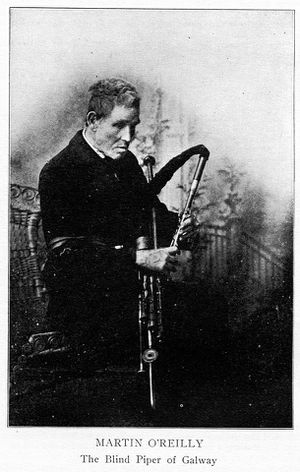Annotation:Light and Airy (2): Difference between revisions
(Philip J. O'Reilly in Chicago would be a more likely source than Martin the piper. It's not a very pipey tune.) |
No edit summary |
||
| (5 intermediate revisions by 2 users not shown) | |||
| Line 1: | Line 1: | ||
{{TuneAnnotation | {{TuneAnnotation | ||
|f_annotation='''LIGHT AND AIRY [2]''' (Eadtrom agus beoda). Irish, Slip Jig (9/8 time). A Mixolydian. Standard tuning (fiddle). AAB. 'Light and Airy' is often a phrase used for the graceful dance the slip jig, traditionally a girl's or woman's dance. | |f_annotation='''LIGHT AND AIRY [2]''' (Eadtrom agus beoda). Irish, Slip Jig (9/8 time). A Mixolydian. Standard tuning (fiddle). AAB. 'Light and Airy' is often a phrase used for the graceful dance the slip jig, traditionally a girl's or woman's dance. The first strain of the slip jig can be compared to the first strain of Robert Ross's 6/8 time jig (see "[[Light and Airy (1)]]." The relationship is obscure, but there is a similarity in the contour and and harmonic structure of the two. | ||
[[File:o'reilly.jpg|300px|thumb|right|Marin O'Reilly]] | [[File:o'reilly.jpg|300px|thumb|right|Marin O'Reilly]] | ||
|f_source_for_notated_version="O'Reilly" [O'Neill]. O'Neill may be referring to Martin O'Reilly [http://en.wikipedia.org/wiki/Martin_O%27Reilly], "The Blind Piper of Galway", the subject of a brief sketch in '''Irish Minstrels and Musicians''' (1913, pp. 239-240). O'Reilly played at the Belfast Harp Restival in 1903 (the same year O'Neill published '''Music of Ireland'''), where he "was the hero of the occasion" on account of his superb playing. | |f_source_for_notated_version="O'Reilly" [O'Neill]. O'Neill may be referring to Martin O'Reilly [http://en.wikipedia.org/wiki/Martin_O%27Reilly], "The Blind Piper of Galway", the subject of a brief sketch in '''Irish Minstrels and Musicians''' (1913, pp. 239-240). O'Reilly played at the Belfast Harp Restival in 1903 (the same year O'Neill published '''Music of Ireland'''), where he "was the hero of the occasion" on account of his superb playing. | ||
<br> | |||
<br> | |||
A more likely source, and one mentioned in the introduction to O'Neill's 1907 '''Dance Music of Ireland''' (1907) collection, would be Philip J. O'Reilly, a fiddler originally from County Cavan. O'Neill, in a 1906 letter to Alfred Percival Graves, described him as a "good player [who] had many old manuscripts." Furthermore, the melody appears to 'sit' better on the fiddle than the pipes. | |||
<br> | |||
<br> | |||
Paul de Grae opines: "The second part, with its accidentals and broken crotchets, hints at drawing room or ballroom origin for this tune"<ref>Paul de Grae, “Notes on Sources of Tunes in the O’Neill Collections”, 2017 [https://www.irishtune.info/public/oneill-sources.htm]. </ref> | Paul de Grae opines: "The second part, with its accidentals and broken crotchets, hints at drawing room or ballroom origin for this tune"<ref>Paul de Grae, “Notes on Sources of Tunes in the O’Neill Collections”, 2017 [https://www.irishtune.info/public/oneill-sources.htm]. </ref> | ||
|f_printed_sources=O'Neill (Krassen), 1976; p. 79. O'Neill ('''Music of Ireland: 1850 Melodies'''), 1903; No. 1119, p. 211. | |f_printed_sources=O'Neill (Krassen), 1976; p. 79. O'Neill ('''Music of Ireland: 1850 Melodies'''), 1903; No. 1119, p. 211. | ||
|f_tune_annotation_title=https://tunearch.org/wiki/Annotation:Light_and_Airy_(2) > | |f_tune_annotation_title=https://tunearch.org/wiki/Annotation:Light_and_Airy_(2) > | ||
Latest revision as of 04:31, 22 June 2021
X:1 T:Light and Airy [2] M:9/8 L:1/8 R:Slip Jig S:O'Neill - Music of Ireland (1903), No. 1119 Z:AK/Fiddler's Companion K:A c2A A2A czA | Bcd ecA Bcd | c2A A2A czA | B2=G GzA Bcd :|| e3 ^d2e czA | Bcd ecA Bcd | e3 ^d2e czA | Bz=G G2A Bcd | e3 ^d2e czA | Bcd ecA Bcd | e3 f3 =g3 | bz=G G2A Bcd ||
LIGHT AND AIRY [2] (Eadtrom agus beoda). Irish, Slip Jig (9/8 time). A Mixolydian. Standard tuning (fiddle). AAB. 'Light and Airy' is often a phrase used for the graceful dance the slip jig, traditionally a girl's or woman's dance. The first strain of the slip jig can be compared to the first strain of Robert Ross's 6/8 time jig (see "Light and Airy (1)." The relationship is obscure, but there is a similarity in the contour and and harmonic structure of the two.


